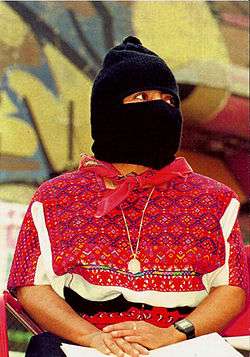Zapatista Army of National Liberation
The Zapatista Army of National Liberation (Ejército Zapatista de Liberación Nacional, EZLN), often referred to as the Zapatistas [sapaˈtistas], is a far-left libertarian-socialist political and militant group that controls a substantial amount of territory in Chiapas, the southernmost state of Mexico.
| Zapatista Army of National Liberation | |
|---|---|
| Participant in the Chiapas conflict | |
 Flag of the EZLN | |
| Active | 1994–present |
| Status | Active |
| Ideology | |
| Political position | Left-wing to far-left |
| Leaders | |
| Area of operations | Chiapas, Mexico |
| Size | About 3,000 active participants and militia; tens of thousands of civilian supporters (bases de apoyo) |
| Allies | Popular Revolutionary Army (Denied by EZLN) |
| Opponent(s) | |
| Battles and war(s) | |
| Website | http://enlacezapatista.ezln.org.mx/ |
| Part of a series on |
| Indigenous rights |
|---|
| Rights |
| Governmental organizations |
| NGOs and political groups |
| Issues |
| Legal representation |
| Category |
Since 1994 the group has been nominally at war with the Mexican state (although it may be described at this point as a frozen conflict).[5] In recent years, the EZLN has focused on a strategy of civil resistance. The Zapatistas' main body is made up of mostly rural indigenous people, but it includes some supporters in urban areas and internationally. The EZLN's main spokesperson is Subcomandante Insurgente Galeano, previously known as Subcomandante Marcos (a.k.a. Compañero Galeano and Delegate Zero in relation to "the Other Campaign"). Unlike other Zapatista spokespeople, Marcos is not an indigenous Maya.[6]
The group takes its name from Emiliano Zapata, the agrarian revolutionary and commander of the Liberation Army of the South during the Mexican Revolution, and sees itself as his ideological heir. Nearly all EZLN villages contain murals with images of Zapata, Ernesto "Che" Guevara, and Subcomandante Marcos.[7]
While EZLN ideology is similar to libertarian socialism, the Zapatistas have rejected[8] and defied[9] political classification. The EZLN aligns itself with the wider alter-globalization, anti-neoliberal social movement, seeking indigenous control over local resources, especially land. Since their 1994 uprising was countered by the Mexican Armed Forces, the EZLN has abstained from military offensives and adopted a new strategy that attempts to garner Mexican and international support.
Organization
The Zapatistas describe themselves as a decentralized organization. The pseudonymous Subcomandante Marcos is widely considered its leader despite his claims that the group has no single leader. Political decisions are deliberated and decided in community assemblies. Military and organizational matters are decided by the Zapatista area elders who compose the General Command (Revolutionary Indigenous Clandestine Committee – General Command, or CCRI-CG).[10]
History
Background
The EZLN emerged during the government of the Institutional Revolutionary Party (PRI), which had ruled Mexico for more than seventy years, in a Dominant-party system. The situation led many young people to consider the legal channels of political participation closed and to bet on the formation of clandestine armed organizations to seek the overthrow of a regime that from their point of view was authoritarian, and thus improve the living conditions of the population. One of these organizations,[11] was known as the National Libertarian Forces (FLN). The FLN were founded on August 6, 1969 by César Germán Yáñez Muñoz, in the north of the country (Monterrey, Nuevo León). According to Mario Arturo Acosta Chaparro, in his report Subversive movements in Mexico, "they had established their areas of operations in the states of Veracruz, Puebla, Tabasco, Nuevo León and Chiapas ".
In February 1974, a confrontation took place in San Miguel Nepantla, State of Mexico, between a unit of the Mexican Army, under the command of Mario Arturo Acosta Chaparro, and members of the FLN, some of whom lost their lives during combat, reported having been tortured.[12]
As a consequence of this confrontation, the FLN lost its operational capacity. In the early 1980s, some of its militants decided to found a new organization. Thus, the Zapatista Army of National Liberation (EZLN) was founded on November 17, 1983 by non-indigenous members of the FLN from Mexico's urban north and by indigenous inhabitants of the remote Las Cañadas/Selva Lacandona regions in eastern Chiapas, by members of former rebel movements. Over the years, the group slowly grew, building on social relations among the indigenous base and making use of an organizational infrastructure created by peasant organizations and the Catholic Church (see Liberation theology).[13]
1990s
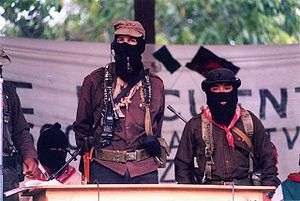
The Zapatista Army went public on January 1, 1994, releasing their declaration on the day the North American Free Trade Agreement (NAFTA) came into effect. On that day, they issued their First Declaration and Revolutionary Laws from the Lacandon Jungle. The declaration amounted to a declaration of war on the Mexican government, which they considered illegitimate. The EZLN stressed that it opted for armed struggle due to the lack of results that had been achieved through peaceful means of protest (such as sit-ins and marches).[14]
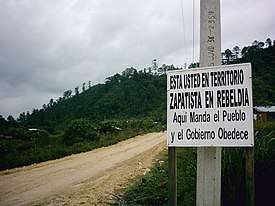
Their initial goal was to instigate a revolution against the rise of neoliberalism[15] throughout Mexico, but since no such revolution occurred, they used their uprising as a platform to call attention to their movement to protest the signing of the NAFTA, which the EZLN believed would increase inequality in Chiapas.[16] The Zapatistas hosted the Intercontinental Encounter for Humanity and Against Neoliberalism to help initiate a united platform for other anti-neoliberal groups.[15] The EZLN also called for greater democratization of the Mexican government, which had been controlled by the Partido Revolucionario Institucional (Institutional Revolutionary Party, also known as PRI) for 65 years, and for land reform mandated by the 1917 Constitution of Mexico which had been repealed in 1991.[17] The EZLN did not demand independence from Mexico, preferring autonomy, land access, and use of natural resources normally extracted from Chiapas. It also advocated for protection from violence and political inclusion of Chiapas' indigenous communities.[18]
On the morning of January 1, 1994, an estimated 3,000 armed Zapatista insurgents seized towns and cities in Chiapas, including Ocosingo, Las Margaritas, Huixtán, Oxchuc, Rancho Nuevo, Altamirano, and Chanal. They freed the prisoners in the jail of San Cristóbal de las Casas and set fire to several police buildings and military barracks in the area. The guerrillas enjoyed brief success, but Mexican army forces counterattacked the next day, and fierce fighting broke out in and around the market of Ocosingo. The Zapatista forces took heavy casualties and retreated from the city into the surrounding jungle.
Armed clashes in Chiapas ended on January 12, with a ceasefire brokered by the Catholic diocese in San Cristóbal de las Casas under Bishop Samuel Ruiz, a well known liberation theologian who had taken up the cause of the indigenous people of Chiapas. The Zapatistas retained some of the land for a little over a year, but in February 1995 the Mexican army overran that territory in a surprise offensive. Following this offensive, the Zapatistas abandoned their villages, and the rebels fled to the mountains after breaking through the Mexican army perimeter.
Military offensive
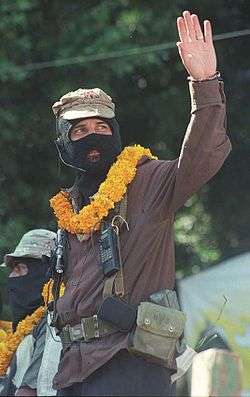
Arrest-warrants were made for Marcos, Javier Elorriaga Berdegue, Silvia Fernández Hernández, Jorge Santiago, Fernando Yanez, German Vicente and other Zapatistas. At that point, in the Lacandon Jungle, the Zapatista Army of National Liberation was under military siege by the Mexican Army. Javier Elorriaga was captured on February 9, 1995, by forces from a military garrison at Gabina Velázquez in the town of Las Margaritas, and was later taken to the Cerro Hueco prison in Tuxtla Gutiérrez, Chiapas. [19] On February 11, 1995, the PGR informed the country that the government had implemented an operation in the State of México, where they had captured 14 people presumed to be involved with the Zapatistas, of which eight had already being turned over to the judicial authorities, they had also seized an important arsenal. [20] The PGR threatened the San Cristóbal de Las Casas' Catholic Bishop, Samuel Ruiz García, with arrest. Claiming that they helped conceal the Zapatistas' guerrilla uprising, although their activities had been reported years before in, Proceso, a major leftist magazine. It is likely however that the Mexican Government knew about the uprising but failed to act.[21][22] [23] This adversely impacted Mexico-Vatican relations.[24]

Under the considerable political pressure of a worsening situation, and believing a peaceful solution to be possible, Mexican Secretary of the Interior Lic. Esteban Moctezuma campaigned to reach a peacefully negotiated solution to the 1995 Zapatista Crisis.
In response to the siege of the EZLN, Moctezuma, the interior minister, submitted his resignation to President Zedillo, which Zedillo refused to accept. Influenced by Moctezuma's protest, President Zedillo abandoned the military offensive in favor of a diplomatic approach. The Mexican army eased its operation in Chiapas, allowing Marcos to escape the military perimeter in the Lacandon jungle.[25] Responding to the change of conditions, friends of the EZLN along with Subcomandante Marcos prepared a report for under-Secretary of the Interior Luis Maldonado Venegas; the Secretary of the Interior Esteban Moctezuma and then President Zedillo.[26] The document stressed Marcos' natural pacifist inclination and an unwillingness to get caught in a bloody war. The document also said that the marginalized groups and the radical left that existed in México supported the Zapatista movement. It also stressed that Marcos maintained an open negotiating track.
2000s
In April 2000, Vicente Fox, the presidential candidate for the opposition National Action Party (PAN), sent a new proposal for dialogue to Subcomandante Marcos, without obtaining a response. In May, a group of civilians attacked two indigenous people from the autonomous municipality of Polhó, Chiapas. Members of the Federal Police were sent to guarantee the security of the area. The Zapatista coordinators and various non-governmental organizations considered it "a clear provocation to the EZLN."[27]
Vicente Fox was elected president in 2001 (the first non-PRI president of Mexico in over 70 years) and, as one of his first actions, urged the EZLN to enter into dialogue with the federal government to achieve peace in Chiapas. However, the EZLN insisted that it would not return to peace negotiations with the government until the seven requested military positions were closed. Fox subsequently made the decision to withdraw the army from the conflict zone, so all the military located in Chiapas began to leave the area. Following this gesture, Subcomandante Marcos agreed to initiate dialogue with the Vicente Fox government, but shortly thereafter demanded conditions for peace; especially, that the federal government disarm the PRI paramilitary groups in the area.[28] The Zapatistas marched on Mexico City to pressure the Mexican Congress and formed the Zapatista Information Center, through which information would be exchanged about the trip of the guerrilla delegation to Mexico City, and mobilizations would be articulated to demand compliance with the conditions of the EZLN for dialogue. Although Fox had stated earlier that he could end the conflict "in fifteen minutes",[29] the EZLN rejected a watered-down agreement and created 32 new "autonomous municipalities" in Chiapas. They would then unilaterally implement their demands without government support, although they had some funding from international organizations.
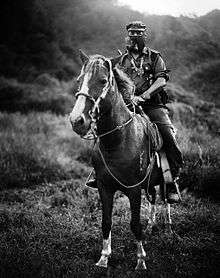
On June 28, 2005, the Zapatistas presented the Sixth Declaration of the Lacandon Jungle[30] declaring their principles and vision for Mexico and the world. This declaration reiterated the support for the indigenous peoples, who make up roughly one-third of the population of Chiapas, and extended the cause to include "all the exploited and dispossessed of Mexico". It also expressed the movement's sympathy to the international alter-globalization movement and supported leftist government Cuba, Bolivia, Ecuador, and elsewhere, with whom they felt there was common cause.
In preparation for this campaign, the Zapatistas invited to their territory over 600 national leftist organizations, indigenous groups, and non-governmental organizations to listen to their claims for human rights in a series of biweekly meetings that culminated in a plenary meeting on September 16, the day Mexico celebrates its independence from Spain. In this meeting, Subcomandante Marcos requested official adherence of the organizations to the Sixth Declaration, and detailed a six-month tour of the Zapatistas through all 31 Mexican states to occur concurrently with the electoral campaign starting January 2006.
On January 1, 2006, the EZLN began a massive tour, "The Other Campaign", encompassing all 31 Mexican states in the buildup to that year's presidential election, which the EZLN made clear they would not participate in directly.
On May 3–4, 2006, a series of demonstrations protested the forcible removal of irregular flower vendors from a lot in Texcoco for the construction of a Walmart branch. The protests turned violent when state police and the Federal Preventive Police bussed in some 5,000 agents to San Salvador Atenco and the surrounding communities. A local organization called the People's Front in Defense of the Land (FPDT), which adheres to the Sixth Declaration, called in support from other regional and national adherent organizations. "Delegate Zero" and his "Other Campaign" were at the time in nearby Mexico City, having just organized May Day events there, and quickly arrived at the scene. The following days were marked by violence, with some 216 arrests, over 30 rape and sexual abuse accusations against the police, five deportations, and one casualty, a 14-year-old boy named Javier Cortes shot by a policeman. A 20-year-old UNAM economics student, Alexis Benhumea, died on the morning of June 7, 2006, after being in a coma caused by a blow to the head from a tear-gas grenade launched by police.[31] Most of the resistance organizing was done by the EZLN and Sixth Declaration adherents, and Delegate Zero stated that the "Other Campaign" tour would be temporarily halted until all prisoners were released.
In late 2006 and early 2007, the Zapatistas (through Subcomandante Marcos), along with other indigenous peoples of the Americas, announced the Intercontinental Indigenous Encounter. They invited indigenous people from throughout the Americas and the rest of the world to gather on October 11–14, 2007, near Guaymas, Sonora. The declaration for the conference designated this date because of "515 years since the invasion of ancient Indigenous territories and the onslaught of the war of conquest, spoils and capitalist exploitation". Comandante David said in an interview, "The object of this meeting is to meet one another and to come to know one another's pains and sufferings. It is to share our experiences, because each tribe is different."[32]
The Third Encuentro of the Zapatistas People with the People of the World was held from December 28, 2007, through January 1, 2008.[33]
In mid-January 2009, Marcos made a speech on behalf of the Zapatistas in which he supported the resistance of the Palestinians as "the Israeli government's heavily trained and armed military continues its march of death and destruction". He described the actions of the Israeli government as a "classic military war of conquest". He said, "The Palestinian people will also resist and survive and continue struggling and will continue to have sympathy from below for their cause."[34]
2010s
On December 21, 2012, tens of thousands of EZLN supporters marched silently through five cities in the state of Chiapas: Ocosingo, Las Margaritas, Palenque, Altamirano and San Cristóbal. Hours after the march, a communiqué from the CCRI-CG was released in the form of a poem, signed by the Subcomandante Marcos.[35] This mobilization, which included the participation of around 40 thousand Zapatistas, was the largest since the 1994 uprising. Of this number, "La Jornada" estimated that half would have marched through the streets of San Cristóbal de las Casas, 7,000 in Las Margaritas and 8,000 in Palenque; for its part El País calculated that San Cristóbal would have seen the concentration of some 10 thousand participants [36][37].
Beyond the number of people, the silence with which they marched and the lack of an opening or closing speech were the elements that marked this action. The poet and journalist Hermann Bellinghausen, specialist in coverage of the movement, ended his chronicle in this way: [38]
Able to "appear" suddenly, the rebellious indigenous "disappeared" as neatly and silently as they had arrived in this city at dawn that, two decades after the EZLN's traumatic uprising here on the new year of 1994, received them with care and curiosity, without any expression of rejection. Under the arches of the mayor's office, which today suspended its activities, dozens of Ocosinguenses gathered to photograph with cell phones and cameras the spectacular concentration of hooded people who filled the park like a game of Tetris, advancing between the planters with an order that seemed choreographed, to get the platform installed quickly from early on, raise their fist and say, quietly, "here we are, once again".[36].
The Zapatistas invited the world to a three-day fiesta to celebrate ten years of Zapatista autonomy in August 2013 in the five caracoles of Chiapas. They expected 1,500 international activists to attend the event, titled the Little School of Liberty.[39][40]
In June 2015, the EZLN reported that there was aggression against indigenous people in El Rosario, Chiapas; The report, signed by Subcomandante Moisés, indicated that the attack occurred that same month and year. In addition, there was a complaint by the Las Abejas Civil Society Organization that stated that an indigenous Tzotzil person was assassinated on June 23 on 2015.[41]
In 2016, at the National Indigenous Congress and the EZLN agreed to select a candidate to represent them in the forthcoming 2018 Mexican general election. This decision broke the Zapatista's two-decade tradition of rejecting Mexican electoral politics. In May 2017, María de Jesús Patricio Martínez was selected to stand. She is Mexican and Nahua.[42][43]
At the end of August 2019, Subcomandante Insurgente Galeano announced the expansion of EZLN into 11 more districts.[44] In response, President Lopez Obrador stated that this expansion was welcome, provided it was done without violence.[45]
Ideology
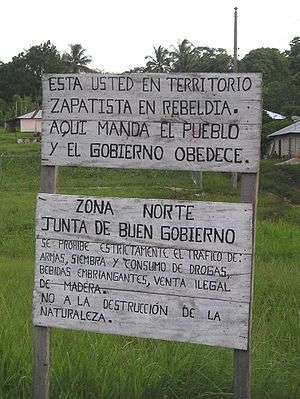
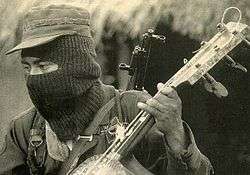
The ideology of the Zapatista movement, Neozapatismo, synthesizes Mayan tradition with elements of libertarian socialism, anarchism,[48][49] and Marxism.[50] The historical influence of Mexican anarchists and various Latin American socialists is apparent in Neozapatismo. The positions of Subcomandante Marcos add a Marxist[51] element to the movement. A Zapatista slogan is in harmony with the concept of mutual aid: "For everyone, everything. For us, nothing" (Para todos todo, para nosotros nada).
The EZLN opposes economic globalization, arguing that it severely and negatively affects the peasant life of its indigenous support base and oppresses people worldwide. The signing of NAFTA also resulted in the removal of Article 27, Section VII, from the Mexican Constitution, which had guaranteed land reparations to indigenous groups throughout Mexico.
Another key element of the Zapatistas' ideology is their aspiration to do politics in a new, participatory way, from the "bottom up" instead of "top down". The Zapatistas consider the contemporary political system of Mexico inherently flawed due to what they consider its purely representative nature and its disconnection from the people and their needs. In contrast, the EZLN aims to reinforce the idea of participatory democracy or radical democracy by limiting public servants' terms to only two weeks, not using visible organization leaders, and constantly referring to the people they are governing for major decisions, strategies, and conceptual visions. Marcos has reiterated, "my real commander is the people". In accordance with this principle, the Zapatistas are not a political party: they do not seek office throughout the state, because that would perpetuate the political system by attempting to gain power within its ranks.
Postcolonialism
The Zapatistas' response to the introduction of NAFTA in 1994, it is argued, reflects the shift in perception taking place in societies that have experienced colonialism.[52] Over the last 20 years, Chiapas is said to have emerged as a formidable force against the Mexican government, fighting against structural violence and social and economic marginalization brought on by globalization.[53] The Zapatista rebellion not only raised many questions about the consequences of globalization and free trade; it also questioned the long-standing ideas created by the Spanish colonial system. Postcolonialism is the antithesis of imperialism because it attempts to explain how the prejudices and restrictions created by colonialism are being overcome.[54] This is especially obvious in countries that have large social and economic inequalities, where colonial ideas are deeply entrenched in the minds of the colonials' descendants.
An early example of the Zapatista resistance and postcolonialism was their use of organizations like the United Nations Economic and Social Council (ECOSOC) to raise awareness for their rebellion and indigenous rights, what critics described as the Mexican government's lack of respect for the country's impoverished and marginalized populations.[55] Appealing to the ECOSOC and other non-governmental bodies may have allowed the Zapatistas to establish a sense of autonomy by redefining their identities both as indigenous people and as citizens of Mexico.[56]
Communications
The EZLN has placed a high priority on forging communication with the rest of Mexico and the world.[57] In the first days of the uprising the EZLN issued a flurry of communiqués to Mexico's national press and soon after also to non-Mexican persons and entities, such as Rigoberta Menchú, and the president, congress and people of the United States. Within a few weeks Subcomandante Marcos, the EZLN's spokesperson, was granting interviews to journalists from both the national and international press, including reporters from The New York Times.
In the years that followed, Marcos and the Zapatistas would issue hundreds of missives, hold encuentros (mass meetings), give numerous interviews, meet high-profile public and literary figures including Oliver Stone, Naomi Klein, Gael García Bernal, Danielle Mitterrand, Régis Debray, John Berger, Eduardo Galeano, Gabriel García Márquez, José Saramago and Manuel Vázquez Montalbán), participate in symposia and colloqiua, deliver speeches, host visits by thousands of national and international activists, and participate in two marches that toured much of the country.[58] Media organizations from North and South America, as well as from many European and several Asian nations, have granted press coverage to the movement and its spokesperson. The EZLN's writings have been translated into at least 14 different languages and Marcos, according to journalist Jorge Alonso, had by 2016 been the subject of ′over 10,000 citations...in the academic world′.[59]
Horizontal autonomy and indigenous leadership

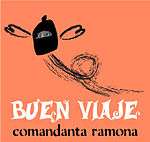
Zapatista communities claim to practice "horizontal autonomy and mutual aid" by building and maintaining their own health, education, and sustainable agro-ecological systems, promoting equitable gender relations via Women's Revolutionary Law, and building international solidarity through humble outreach and non-imposing political communication. In addition to their focus on building "a world where many worlds fit". The Zapatista struggle re-gained international attention in May 2014 with the death of teacher and education promoter Galeano, who was murdered in an attack on a Zapatista school and health clinic led by local paramilitaries.[60] In the weeks that followed, thousands of Zapatistas and national and international sympathizers mobilized and gathered to honor Galeano. This event also saw the unofficial spokesperson of the Zapatistas, Subcomandante Marcos, announce that he would be stepping down,[61] symbolizing a shift in the EZLN to completely Indigenous leadership.
Notable members
- Subcomandante Insurgente Galeano, previously known as Subcomandante Marcos
- Comandanta Ramona
- Subcomandante Elisa
- Comandanta Esther
In popular culture

- Rap metal group Rage Against the Machine's 1996 single "People of the Sun" is about the Zapatista uprising and features footage of Zapatistas in its music video. The group also incorporates the Zapatista flag in its concerts (lead singer Zack de la Rocha's grandfather fought in the Mexican Revolution, and de la Rocha saw this struggle reflected in the Zapatistas).
- Indie rock group Swirlies' song "San Cristobal de las Casas" featured on their 1995 EP and 1996 album, is about the Zapatista uprising and paramilitary backlash.
- Mexican rock band Caifanes themed a song after the EZLN entitled "El Comunicador".
- Franco-Spanish songwriter Manu Chao performed a song for the EZLN on his 2002 live album, Radio Bemba Sound System.
- Spanish ska group Ska-P's 1998 song Paramilitar references the EZLN.
See also
- Rebel Autonomous Zapatista Municipalities
- A Place Called Chiapas, a documentary on the Zapatistas and Subcomandante Marcos.
- Chiapas conflict
- Himno Zapatista, anthem of the Zapatistas
- Popular Revolutionary Army
- Index of Mexico-related articles
- Indigenous movements in the Americas
- Indigenous peoples of Mexico
- Mexican Indignados Movement
- San Andrés Accords
- Zapatismo
- Zapatista coffee cooperatives
- Women in the EZLN
References
Footnotes
- Prichard, Alex; Kinna, Ruth; Pinta, Saku; Berry, David Berry (2017). Libertarian Socialism: Politics in Black and Red. PM Press. p. 18. ISBN 978-1-62963-402-9.
... in the period since the fall of the Berlin Wall, two events stand out as examples of libertarian socialist experimentation: the Zapatista uprising in Chiapas, Mexico in 1994 ...
- Day, Richard J. F. (2005). Gramsci is Dead: Anarchist Currents in the Newest Social Movements. Pluto Press. p. 195. ISBN 978-0-7453-2112-7.
- "Defining Mexico's Zapatista Army of National Liberation". October 22, 2012.
- "CNI and EZLN: Despite Aggressions, the Consultation Continues".
- "A brief history of the Zapatista Army of National Liberation". ROAR Magazine. Retrieved November 13, 2016.
- Gahman, Levi: Zapatistas Begin a New Cycle of Building Indigenous Autonomy http://www.cipamericas.org/archives/12372/
- Baspineiro, Alex Contreras. "The Mysterious Silence of the Mexican Zapatistas." Narco News (May 7, 2004).
- "The EZLN is NOT Anarchist – A Zapatista Response Archived August 13, 2009, at the Wayback Machine"
- "A Commune in Chiapas? Mexico and the Zapatista Rebellion"
- Mazarr, Michael J. (2002). Information Technology and World Politics. Palgrave Macmillan. p. 44. ISBN 978-0-230-10922-3.
- See, also, the Party of the Poor (PDLP) and the Liga Comunista 23 de Septiembre.
- ""'Subcomandante Elisa' denounces torture"". El País. February 12, 1995.
- Gloria Muñoz Ramírez (2003). 20 and 10 the fire and the word.
- "SIPAZ, International Service for Peace webisite, "1994"". Archived from the original on November 17, 2015.
- Olesen, Thomas (2006). Latin American Social Movements. Lanham, Maryland: Rowman & Littlefield Publishers, Inc. p. 187.
- "Rising Inequality in Mexico: Returns to Household Characteristics and the 'Chiapas Effect' by César P. Bouillon, Arianna Legovini, Nora Lustig :: SSRN". Papers.ssrn.com. November 1, 1999. doi:10.2139/ssrn.182178. SSRN 182178. Cite journal requires
|journal=(help) - O'Neil et al. 2006, p. 377.
- Manaut, Raúúl Beníítez; Selee, Andrew; Arnson, Cynthia J. (February 1, 2006). "Frozen Negotiations: The Peace Process in Chiapas" (PDF). Mexican Studies/Estudios Mexicanos. 22 (1): 131–152. doi:10.1525/msem.2006.22.1.131. ISSN 0742-9797.
- ""La Jornada: mayo 4 de 1996»". unam.mx. Retrieved March 13, 2018.
- "U.S. military aids Mexico's attacks on Zapatista movement". afn.org.
- "La Sedena sabía de la existencia de la guerrilla chiapaneca desde 1985 (Segunda y última parte) - Proceso Portal de Noticias". March 20, 2006. Archived from the original on November 3, 2013.
- «Ganaderos e indígenas hablan de grupos guerrilleros»
- «Salinas recibió informes sobre Chiapas, desde julio del 93»
- Jornada, La. "A 15 años de relaciones entre México y el Vaticano – La Jornada". jornada.unam.mx. Retrieved March 13, 2018.
- México, El Universal, Compañia Periodística Nacional. "El Universal – Opinion – Renuncia en Gobernación". eluniversalmas.com.mx. Retrieved March 13, 2018.
- "«Tampico la conexión zapatista»". Archived from the original on November 3, 2013.
- "Chronology of the EZLN Conflict". www.latinamericanstudies.org. Retrieved August 11, 2018.
- "The EZLN and the return to its radical proposal".
- O'Neil et al. 2006, p. 378.
- Sixth Declaration of the Lacandon Jungle on Wikisource
- Alcántara, Liliana. "Dan el último adiós a Alexis Benhumea". El Universal. Retrieved March 3, 2011.
- Norrell, Brenda. "Zapatistas Select Yaqui to Host Intercontinental Summit in Mexico". Narco News (May 7, 2007).
- "ZeztaInternazional". ZeztaInternazional (in Aragonese). Retrieved August 2, 2020.
- "Zapatista Commander: Gaza Will Survive" Archived January 17, 2009, at the Wayback Machine Palestine Chronicle
- "Communiqué of the Clandestine Revolutionary Indigenous Committee – Command General of the Zapatista Army of National Liberation". Enlace Zapatista. December 21, 2012.
- Bellinghausen, Hermann (December 22, 2012). "Mobilized more than 40 thousand zapatistas in 5 municipalities of Chiapas" (10194). Ocosingo, Chiapas, Mexico: La Jornada. p. 2. Retrieved January 7, 2019.
- "Zapatistas are crowding Chiapas". El País. December 22, 2012. Retrieved January 7, 2019.
- Villamil, Jenaro (January 1, 2019). "EZLN, balance at 25 years". Mexico City: Magazine Revista. Retrieved January 7, 2019.
- Leonidas Oikonomakis on August 6, 2013 Zapatistas celebrate 10 years of autonomy with ‘escuelita’ http://roarmag.org/2013/08/escuelita-zapatista-10-year-autonomy/
- "the Little School of Liberty according to the Zapatistas" http://enlacezapatista.ezln.org.mx/2013/08/04/votan-iv-dia-menos-7/
- Hernández, Elio (June 27, 2015). "The EZLN reports aggression against indigenous Zapatista support bases in Ocosingo". San Cristóbal de las Casas, Chiapas: La Jornada.
- "Dismantling Power: The Zapatista Indigenous Presidential Candidate's Vision to Transform Mexico from Below". CounterPunch. Retrieved March 13, 2018.
- Fitzwater, Dylan Eldredge. "Zapatistas and Indigenous Congress Seek to Revolutionize Mexico's 2018 Election". Truthout. Retrieved March 13, 2018.
- Oikonomakis, Leonidas (August 19, 2019). "Zapatistas announce major expansion of autonomous territories". ROAR Mag.
- "Zapatista rebels extend control over areas in south Mexico". WTOP. May 19, 2019. Retrieved September 26, 2019.
- EZLN reitera rechazo a megaproyectos de AMLO El Segundero, January 1, 2020
- "El CNI esboza su estrategia contra el Tren Maya" [The CNI lays out it strategy against the Maya Train]. Proceso (in Spanish). January 4, 2020.
- "Morgan Rodgers Gibson (2009) 'The Role of Anarchism in Contemporary Anti-Systemic Social Movements', Website of Abahlali Mjondolo, December, 2009". Abahlali.org. Retrieved October 29, 2013.
- "Morgan Rodgers Gibson (2010) 'Anarchism, the State and the Praxis of Contemporary Antisystemic Social Movements, December, 2010". Abahlali.org. Retrieved October 29, 2013.
- "The Zapatista Effect: Information Communication Technology Activism and Marginalized Communities Archived August 16, 2011, at the Wayback Machine"
- "The Zapatista's Return: A Masked Marxist on the Stump"
- Beardsell, Peter (2000). Europe and Latin America: Returning the Gaze. Manchester, UK: Manchester University Press.
- Collier, George (2003). A Generation of Crisis in the Central Highlands of Chiapas. Rowmand and Littlefield Publishers Inc. p. 33.
- Lunga, Victoria (2008). "Postcolonial Theory: A Language for a Critique of Globalization". Perspectives on Global Development and Technology. 7 (3/4): 191–199. doi:10.1163/156914908x371349.
- Jung, Courtney (2003). "The Politics of Indigenous Identity, Neoliberalism, Cultural Rights, and the Mexican Zapatistas". Social Research. 70 (2): 433–462. JSTOR 40971622.
- Hiddleston, Jane (2009). Understanding Movements in Modern Thought: Understanding Postcolonialism. Durham, UK: Acumen.
- Benjamin Ferron, La communication internationale du zapatisme (1994–2006), Rennes, Presses Universitaires de Rennes, Res Publica, 2015
- Nick Henck, Subcomandante Marcos: Global Rebel Icon(Montreal: 2019), pp. 26–39
- Nick Henck, Subcomandante Marcos: Global Rebel Icon(Montreal: 2019), pp. 85 & 146, nn. 146 &147
- Gahman, Levi – Death of a Zapatista http://rabble.ca/news/2014/06/death-zapatista-neoliberalisms-assault-on-indigenous-autonomy/
- "Mexico's Zapatista rebel leader Subcomandante Marcos steps down". BBC. May 26, 2014. Retrieved November 15, 2015.
Bibliography
- Collier, George A. (2008). Basta!: Land and the Zapatista Rebellion in Chiapas (3rd. ed.). Food First Books. ISBN 978-0-935028-97-3.
- (Ed.) Ponce de Leon, J. (2001). Our Word Is Our Weapon: Selected Writings, Subcomandante Marcos. New York: Seven Stories Press. ISBN 1-58322-036-4.
- Harvey, Neil (1998). The Chiapas Rebellion: The Struggle for Land and Democracy. Duke University Press. ISBN 0-8223-2238-2.
- O'Neil, Patrick H.; Fields, Karl; Share, Don (2006). Cases in Comparative Politics (2nd ed.). New York: W. W. Norton. ISBN 0-393-92943-4.
- Conant, J. (2010). A Poetics of Resistance: The Revolutionary Public Relations of the Zapatista Insurgency. Oakland: AK Press. ISBN 978-1-849350-00-6.
- Klein, H. (2015). Compañeras: Zapatista Women's Stories. New York: Seven Stories Press. ISBN 978-1-60980-587-6.
- Oikonomakis, Leonidas (2019). Political Strategies and Social Movements in Latin America: The Zapatistas and Bolivian Cocleros. Palgrave Macmillan. ISBN 978-3-319-90203-6.
Further reading
- Castellanos, L. (2007). México Armado: 1943-1981. Epilogue and chronology by Alejandro Jiménez Martín del Campo. México: Biblioteca ERA. 383 pp. ISBN 968-411-695-0 ISBN 978-968-411-695-5
- Patrick & Ballesteros Corona, Carolina (1998). Cuninghame, "The Zapatistas and Autonomy", Capital & Class, No. 66, Autumn, pp 12–22.
- The Zapatista Reader edited by Tom Hayden 2002 A wide sampling of notable writing on the subject. ISBN 9781560253358
- Khasnabish, Alex (2010). Zapatistas: Rebellion from the Grassroots to the Global. London and New York: Zed Books. ISBN 978-1848132085.
- Klein, Hilary. (2015) Compañeras: Zapatista Women's Stories. Seven Stories Press. ISBN 9781609805876
- (Eds.) Holloway, John and Peláez, Eloína (1998). Zapatista! Reinventing Revolution in Mexico. London: Pluto Press.| ISBN 978-0745311777.
- Mentinis, Mihalis (2006). Zapatistas: The Chiapas Revolt and what it means for Radical Politics. London: Pluto Press. ISBN 978-0745324869.
- Muñoz Ramírez, Gloria (2008). The Fire and the Word: A History of the Zapatista Movement. San Francisco: City Lights Publishers. ISBN 978-0872864887.
- Ross, John (1995). Rebellion from the Roots: Indian Uprising in Chiapas. Monroe, ME.: Common Courage Press. ISBN 978-1567510430.
- Ross, John (2000). The War Against Oblivion: the Zapatista Chronicles 1994–2000. Monroe, ME: Common Courage Press. ISBN 978-1567511741.
- Ross, John (2006). ¡Zapatistas! Making Another World Possible: Chronicles of Resistance 2000–2006. New York: Nation Books. ISBN 978-1560258742.
- Subcomandante Marcos (2016). Critical Thought in the Face of the Capitalist Hydra. Durham, NC: Paperboat Press. ISBN 978-0979799327.
- Subcomandante Marcos (2018). The Zapatistas’ Dignified Rage: Final Public Speeches of Subcommander Marcos. Nick Henck (ed.) and Henry Gales (trans.). Chico, CA.: AK Press. ISBN 978-1849352925.
External links
| Wikimedia Commons has media related to Zapatista Army of National Liberation. |
| Wikisource has original text related to this article: |
- Official website (in Spanish)
- Schools for Chiapas
- EZLN Communiques (1994–2004) translated into English
- Our Word Is Our Weapon by Subcomandante Marcos Chapter 1
- "What is it that is Different About the Zapatistas?"
- Zapatista by Blake Bailey
- A Celebration of the Struggle of the Zapatista Women
- Occupy Movement, the Zapatistas and the General Assemblies
- The Narco News Bulletin – Articles on the Zapatistas
- "A Commune in Chiapas? Mexico and the Zapatista Rebellion (1994–2000)" by LibCom.org
- "Visiting the Zapatistas" by Nick Rider, New Statesman, March 12, 2009
- "Commodifying the Revolution: Zapatista Villages Become Hot Tourist Destinations" by John Ross
- A Glimpse Into the Zapatista Movement, Two Decades Later by Laura Gottesdiener. The Nation, January 23, 2014.
- We All Must Become Zapatistas (2014.06.02), Chris Hedges, Truthdig
